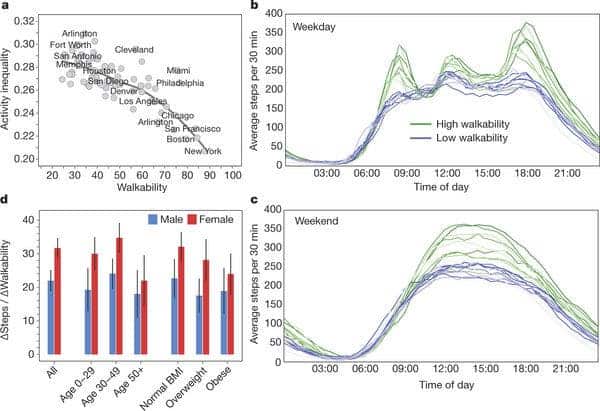A new study amassed “planetary-scale” data from people’s smartphones to see how active they are. They found that people from Hong Kong are the most active (6,880 steps a day), while Indonesians fared the worst (3,513).

In a world that’s struggling to deal with an obesity pandemic, day-to-day physical activity is an important and underrated way of losing some pounds and staying (at least somewhat) fit. With that in mind, Stanford Researchers used data from 700,000 people who used the Argus activity monitoring app, analyzing 68 million days’ worth of minute-by-minute data. They found that worldwide, people take an average of 4,961 steps a day. Generally speaking, eastern Europe and eastern Asia seem more active, with Indonesia, Pakistan, and the Arab peninsula being the laziest.
Of course, walking is just one measure of how active a country is. While walking is the most popular physical activity worldwide (though we don’t often think of it that way), the study fails to capture activities where it’s impractical to carry a phone (such as playing ball games or swimming), and other ways of physical locomotion (ie cycling). Still, it’s a trove of data, and by far the largest such effort undertaken so far.
“The study is 1,000 times larger than any previous study on human movement,” said Scott Delp, a professor of bioengineering and one of the researchers in the study. “There have been wonderful health surveys done, but our new study provides data from more countries, many more subjects, and tracks people’s activity on an ongoing basis. This opens the door to new ways of doing science at a much larger scale than we have been able to do before.”
The study revealed an interesting pattern: there wasn’t a direct connection between fewer steps and obesity rates. Instead, obesity rates correlated with “activity inequality.” Just like social inequality is an indicator of how well a country’s population is doing, activity inequality seems to be a great indicator of obesity rates. Basically, countries with a high activity inequality also had higher obesity rates. For instance, people from the United States and Mexico walked just as much, but inequality was much higher in the US — and so is the obesity rate. Another interesting finding is that in such countries, with a high inequality, the inequality is largely driven by differences between men and women. So when you draw the line, countries where women walk significantly less than men tend to be countries with high obesity rates.
As a notable counter-example, in Japan, where men and women exhibit similar levels of physical activity, obesity rates are very low. Researchers have some idea about why this is happening. Jure Leskovec, also part of the research team, explained:
“When activity inequality is greatest, women’s activity is reduced much more dramatically than men’s activity, and thus the negative connections to obesity can affect women more greatly.”

They also carried out an analysis of the city walkability. Not surprisingly, cities that were more walkable encouraged people to walk more and stay healthier. Walkability is a complex element, which gives scores from 1 to 100 to amenities (such as shops and parks) within a 0.25 to 1.5 mile radius and measures of friendliness to pedestrians, measuring factors such as city block length and intersection density. For the 69 cities in the USA with at least 200 users, walkability scores correlated with activity inequality, which in turn correlated with obesity. So if you want people to lose weight, make it easier for them to walk the city. It might seem like a no-brainer, but it’s good to have the big data to back it up.
Researchers actually hope their work can enable city officials and policy makers to make cities more friendly to pedestrians. Of course, curving down obesity will involve a broader approach, focusing on nutrition as well as physical activity, but walking is beneficial in more ways than one. Encouraging people to walk can make a great difference in a city’s health, also reducing emissions as a nice side effect.
The study was published in Nature.



